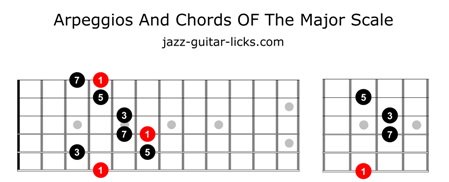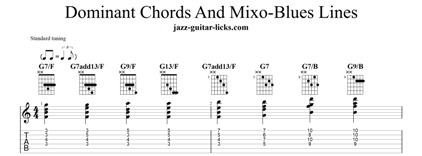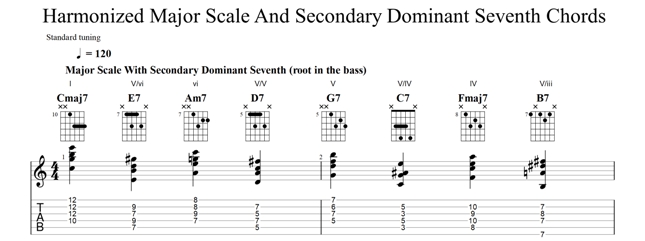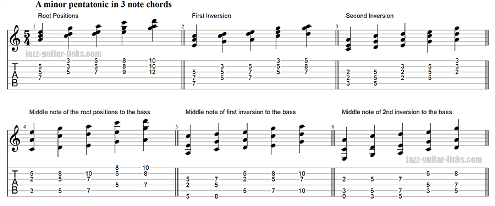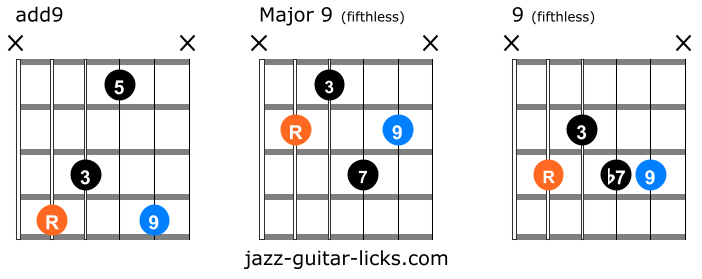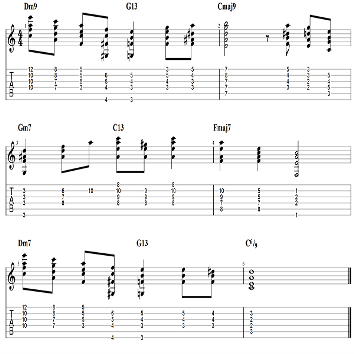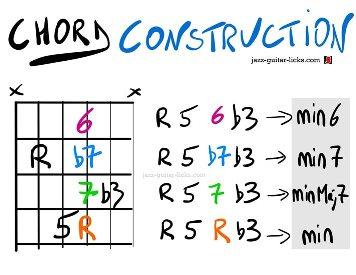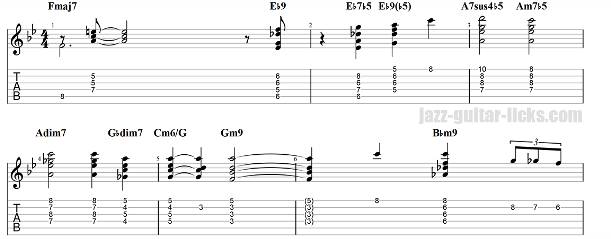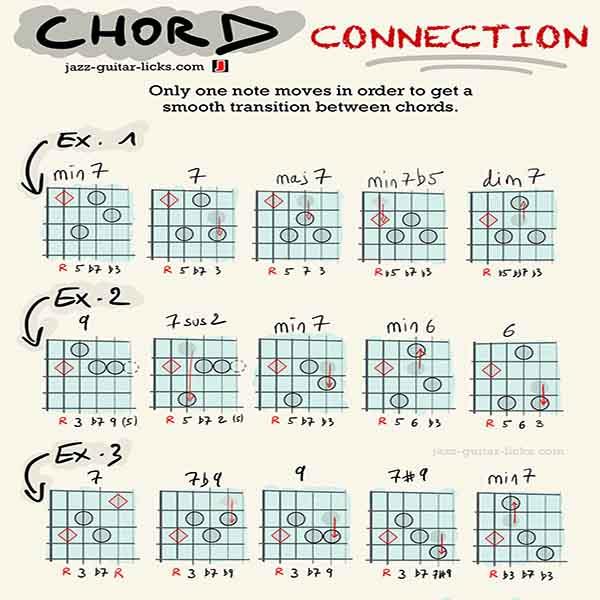guitar chords
-
Arpeggios And Chords Of The Major Scale For Guitar - Free PDF
- By jazz-guitar-licks
- On 2024-09-23
- In Scales & Arpeggios
- 0 comments
Here’s a breakdown of seventh arpeggios and their related chords based on the major scale for guitar.
An arpeggio is essentially the notes of a chord played individually.
Seventh arpeggios add a fourth note (the seventh) to each triad, giving a more complex and richer sound.
In this guitar lesson, we'll be focusing on the arpeggios of the seventh chords derived from the G major scale.
You'll find the free PDF (or name a fair price) here in the GUMROAD Store.
-
Extended Shell Voicings For Guitar
- By jazz-guitar-licks
- On 2024-09-06
- 2 comments
Harmonizing the major scale using 3-note chords, also known as shell voicings, is a fundamental technique used in jazz and contemporary music.
-
14 Dominant Chords And Mixo Blues Lines / Voice Leading / Guitar Lesson With Free PDF & Short YouTube Video
- By jazz-guitar-licks
- On 2023-09-15
- In Jazz Guitar Lessons
- 0 comments
This short guitar lesson provides 14 ways of connecting dominant chord voicings on the same string set (7 and extended) and three easy lines using the Mixo Blues Scale. A free transcription in PDF (or give what you want) is available here on the GUMROAD store.
-
Major Scale And Secondary Dominant Seventh Chords - Free PDF Transcription And Short Videos
- By jazz-guitar-licks
- On 2023-08-17
- 0 comments
This guitar lesson implies playing secondary dominant seventh chords of the harmonized major scale. Free PDF available on GUMROAD and four YouTube short videos at the bottom of this page.
-
Harmonization of Minor Scales On Guitar - Natural, Melodic and Harmonic Minor
- By jazz-guitar-licks
- On 2023-08-03
- 0 comments
Harmonization of minor scales involves creating chords by stacking thirds on each note of the scale.
There are three common types of minor scales: natural minor, melodic minor, and harmonic minor.
This guitar lesson explore each one and explain how to harmonize them on guitar.
-
Dominant, Subdominant, Secondary Subdominant and Secondary Dominant Chords - Guitar Theory Lesson
- By jazz-guitar-licks
- On 2023-07-30
- 0 comments
In music theory, the terms "dominant," "subdominant," and "secondary dominant" are used to describe different types of chords and their functions within a key or harmonic progression. Here's an explanation of each term with examples for guitar players.
-
Harmonization Of The Minor Pentatonic Scale On Guitar
- By jazz-guitar-licks
- On 2023-06-30
- 0 comments
Harmonizing the minor pentatonic scale involves creating chords that complement the scale and enhance its melodic possibilities. Here's a step-by-step guide on how to harmonize the minor pentatonic scale on guitar:
-
Solar By Miles Davis - 2 Chord Studies For Beginners
- By jazz-guitar-licks
- On 2023-05-23
- 0 comments
Here are two easy guitar chord studies to apply over the jazz tune Solar by Miles Davis. The first one implies 3-Note chords while the second implies 4-note chords. Free PDF and YouTube Short video available.
-
Difference Between Fully Diminished 7 And Half-Diminished - Guitar Lesson With Formula Chart And Neck Diagrams
- By jazz-guitar-licks
- On 2022-11-28
- 0 comments
This blog article dedicated to guitarists answers the question that many beginner musicians ask themeselves : What is the difference between half-diminished and fully diminished (Diminished 7) ?
-
Differences Between Maj9, add9 and 9 Chords - Music Theory For Guitar With Charts And Neck Diagrams
- By jazz-guitar-licks
- On 2022-11-16
- 0 comments
This guitar lesson with charts and shapes will help you understanding the differences between major 9, add9 and dominant 9 Chords. How they are built and how to play them on guitar.
-
2-5-1 Guitar Chord Voicings - Joe Pass Style - Video and Free PDF
- By jazz-guitar-licks
- On 2022-05-17
- 0 comments
Here is a free lesson to learn some 2-5-1 jazz chord voicings in the style of Joe Pass. PDF with tab and Youtube short video available for free (or give what you want) here in the GUMROAD ONLINE SHOP.
-
Difference Between Dominant 7 and Major 7 Chords - Music Theory For Guitar
- By jazz-guitar-licks
- On 2022-04-04
- In Chords / Voicings
- 0 comments
This theory lesson for guitarists covers one the most common question asked by beginner musicians : what's the difference between a dominant seventh and a major seventh chord.
-
Guitar Chord Construction and Connection - Cheat Sheets With Shapes and Intervals
- By jazz-guitar-licks
- On 2021-12-12
- In Chords / Voicings
- 0 comments
This page provides a collection of cheat sheets explaining in a simple and effective way how guitar chords are built and how they are connected one to the other. The idea is to understand where are located each chord tone of a specific voicing and how to connect these chords them by moving only one note at a time. Notice that this page is regularly updated with new shapes, don't forget to subscribe the newsletter to stay informed.
-
Days of Wine And Roses - Guitar Chord Melody Lesson With Tab
- By jazz-guitar-licks
- On 2021-10-19
- 0 comments
This lesson provides a chord melody arrangement for guitar of the famous song "Days of Wine and Roses" written by Henry Mancini (music) and Johnny Mercer (lyrics) for the movie film of the same name.
-
Extended and Altered Dominant Guitar Chord Shapes - Free PDF Chart
- By jazz-guitar-licks
- On 2021-10-04
- In Guitar Cheat Sheets, Methods, eBooks, Posters
- 0 comments
This free guitar chord chart available as a PDF file contains the most important altered and extended dominant guitar chord shapes that any guitar player should know. It is totally free (or Pay What You Want) in return, don't hesitate to support this website.
-
Chord Connections - 3 Exercises For Guitar - PDF Cheat Sheet
- By jazz-guitar-licks
- On 2021-09-20
- In Chords / Voicings
- 0 comments
Here is a cheat sheet containing three easy exercises for connecting basic guitar chord shapes as min7, maj7, dim7, m7b5, 7sus, 9th, 7#9, 7b9, min6, 6. It is available for free (or Pay What You Want) in Jazz Guitar Licks Gumroad Shop.
